Aboriginal Mental Health: Barriers & Human Services Implications
VerifiedAdded on 2023/06/07
|9
|2400
|171
Essay
AI Summary
This essay examines the significant barriers to mental health service utilization among Aboriginal Australians, focusing primarily on the detrimental impact of stigma, both public and self-imposed, which leads to reluctance in seeking necessary care. Beyond stigma, the essay explores how communication barriers arising from language differences and cultural values, socio-economic status impacting affordability and access, and the challenges posed by rural locations with limited resources, all contribute to the underutilization of mental health services. It highlights the importance of addressing these barriers through public education to reduce stigma, culturally sensitive communication strategies, affordable healthcare options, and improved resource allocation in rural areas to enhance the delivery of human services and improve mental health outcomes for Aboriginal communities. The essay concludes by emphasizing the need for collaborative efforts between the government, caregivers, and communities to ensure equitable access to quality mental healthcare for all Aboriginal Australians.
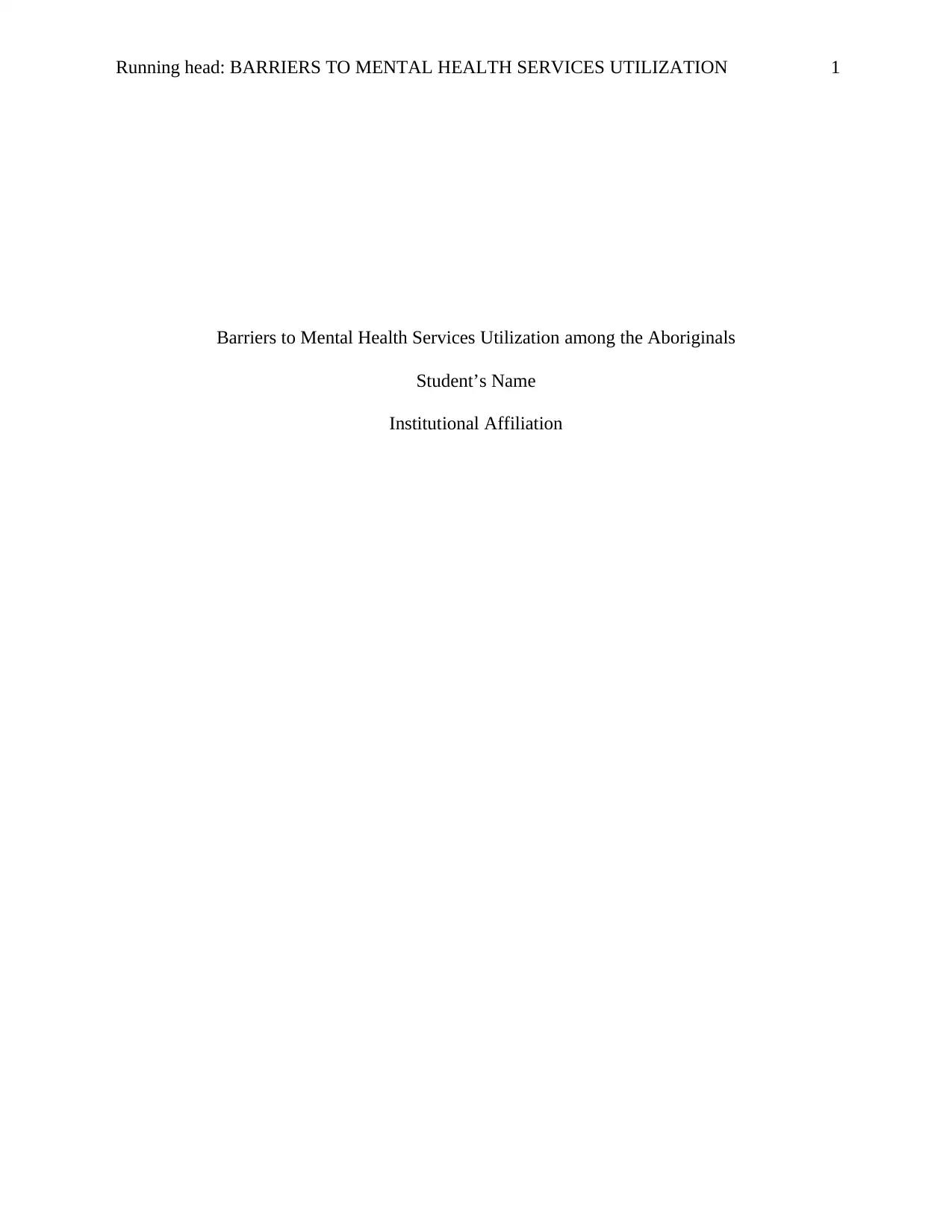
Running head: BARRIERS TO MENTAL HEALTH SERVICES UTILIZATION 1
Barriers to Mental Health Services Utilization among the Aboriginals
Student’s Name
Institutional Affiliation
Barriers to Mental Health Services Utilization among the Aboriginals
Student’s Name
Institutional Affiliation
Paraphrase This Document
Need a fresh take? Get an instant paraphrase of this document with our AI Paraphraser
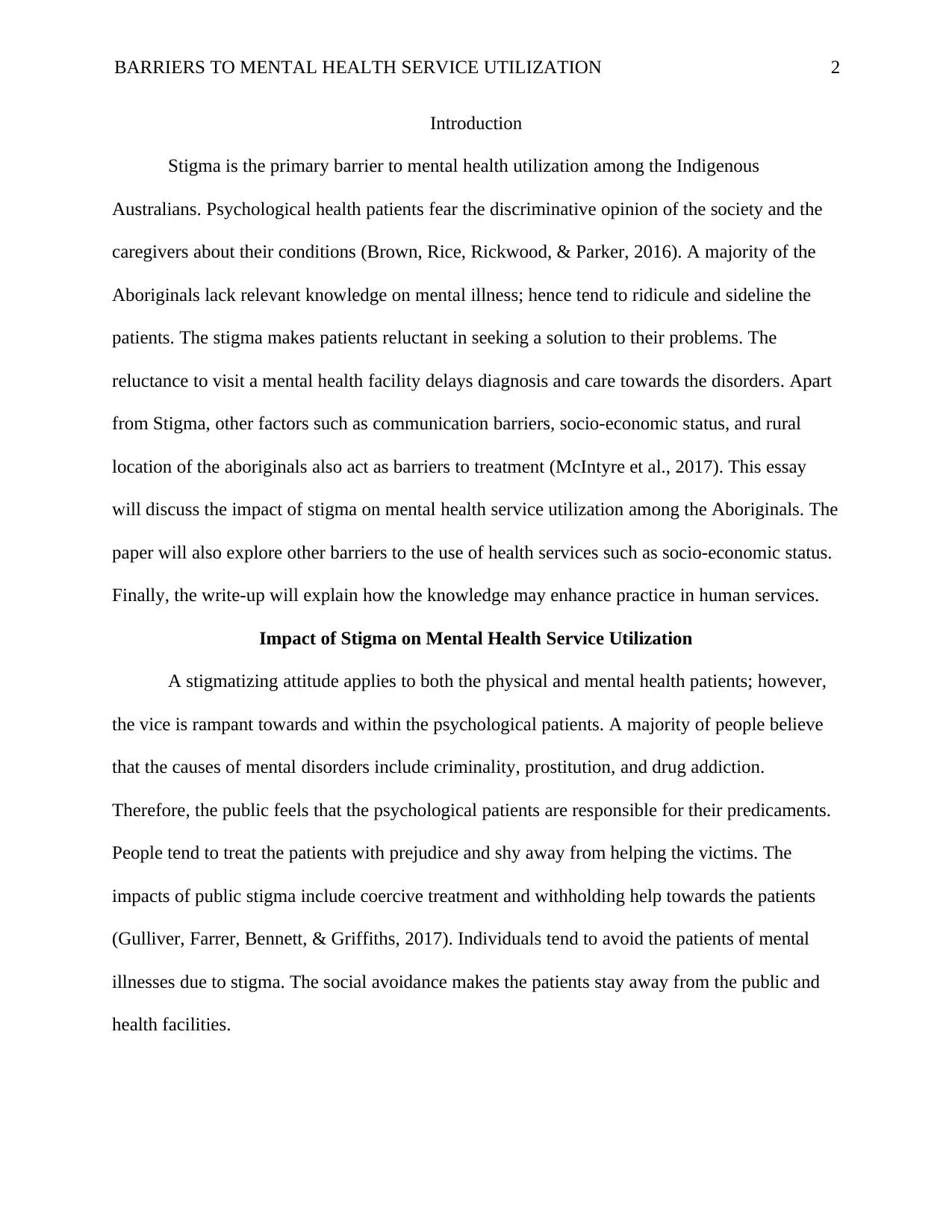
BARRIERS TO MENTAL HEALTH SERVICE UTILIZATION 2
Introduction
Stigma is the primary barrier to mental health utilization among the Indigenous
Australians. Psychological health patients fear the discriminative opinion of the society and the
caregivers about their conditions (Brown, Rice, Rickwood, & Parker, 2016). A majority of the
Aboriginals lack relevant knowledge on mental illness; hence tend to ridicule and sideline the
patients. The stigma makes patients reluctant in seeking a solution to their problems. The
reluctance to visit a mental health facility delays diagnosis and care towards the disorders. Apart
from Stigma, other factors such as communication barriers, socio-economic status, and rural
location of the aboriginals also act as barriers to treatment (McIntyre et al., 2017). This essay
will discuss the impact of stigma on mental health service utilization among the Aboriginals. The
paper will also explore other barriers to the use of health services such as socio-economic status.
Finally, the write-up will explain how the knowledge may enhance practice in human services.
Impact of Stigma on Mental Health Service Utilization
A stigmatizing attitude applies to both the physical and mental health patients; however,
the vice is rampant towards and within the psychological patients. A majority of people believe
that the causes of mental disorders include criminality, prostitution, and drug addiction.
Therefore, the public feels that the psychological patients are responsible for their predicaments.
People tend to treat the patients with prejudice and shy away from helping the victims. The
impacts of public stigma include coercive treatment and withholding help towards the patients
(Gulliver, Farrer, Bennett, & Griffiths, 2017). Individuals tend to avoid the patients of mental
illnesses due to stigma. The social avoidance makes the patients stay away from the public and
health facilities.
Introduction
Stigma is the primary barrier to mental health utilization among the Indigenous
Australians. Psychological health patients fear the discriminative opinion of the society and the
caregivers about their conditions (Brown, Rice, Rickwood, & Parker, 2016). A majority of the
Aboriginals lack relevant knowledge on mental illness; hence tend to ridicule and sideline the
patients. The stigma makes patients reluctant in seeking a solution to their problems. The
reluctance to visit a mental health facility delays diagnosis and care towards the disorders. Apart
from Stigma, other factors such as communication barriers, socio-economic status, and rural
location of the aboriginals also act as barriers to treatment (McIntyre et al., 2017). This essay
will discuss the impact of stigma on mental health service utilization among the Aboriginals. The
paper will also explore other barriers to the use of health services such as socio-economic status.
Finally, the write-up will explain how the knowledge may enhance practice in human services.
Impact of Stigma on Mental Health Service Utilization
A stigmatizing attitude applies to both the physical and mental health patients; however,
the vice is rampant towards and within the psychological patients. A majority of people believe
that the causes of mental disorders include criminality, prostitution, and drug addiction.
Therefore, the public feels that the psychological patients are responsible for their predicaments.
People tend to treat the patients with prejudice and shy away from helping the victims. The
impacts of public stigma include coercive treatment and withholding help towards the patients
(Gulliver, Farrer, Bennett, & Griffiths, 2017). Individuals tend to avoid the patients of mental
illnesses due to stigma. The social avoidance makes the patients stay away from the public and
health facilities.
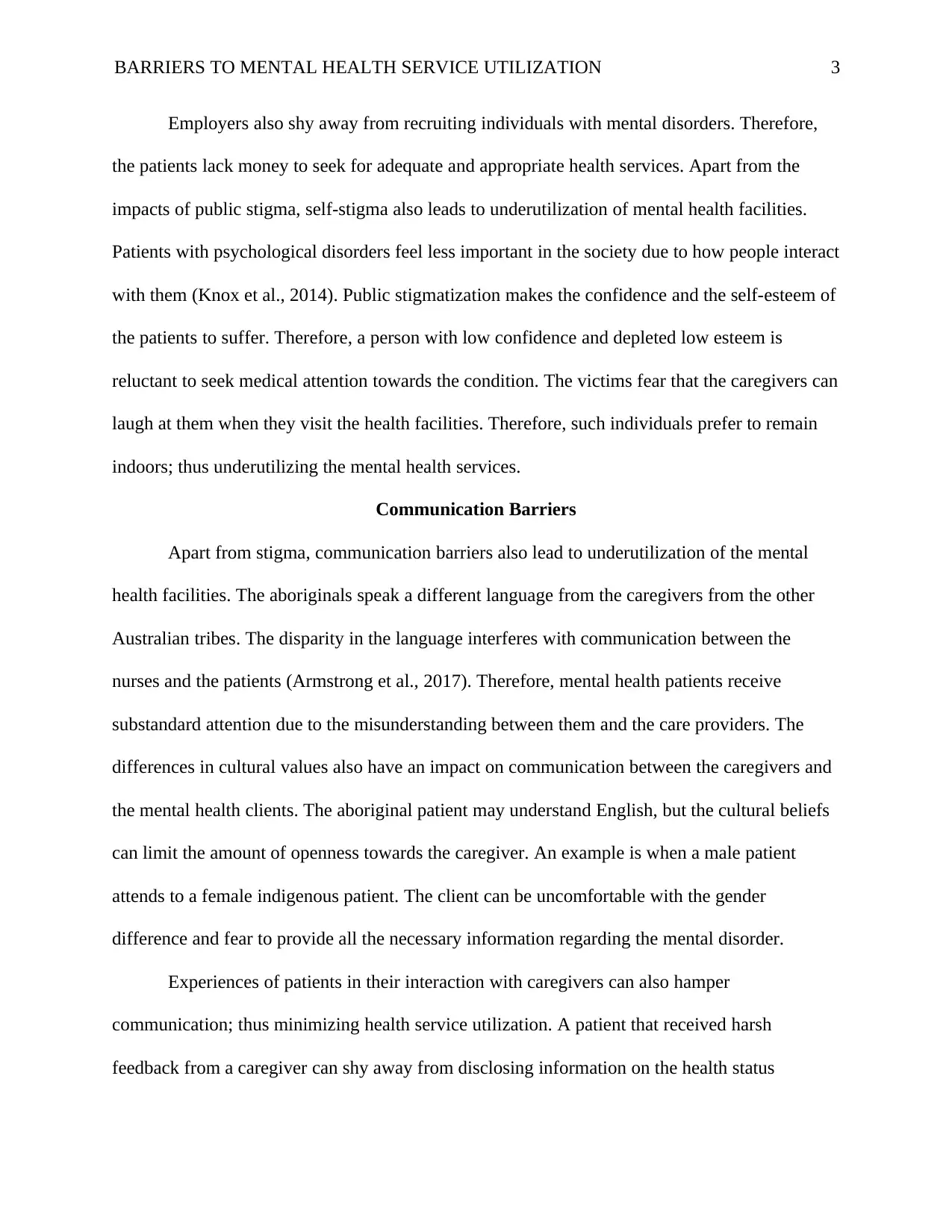
BARRIERS TO MENTAL HEALTH SERVICE UTILIZATION 3
Employers also shy away from recruiting individuals with mental disorders. Therefore,
the patients lack money to seek for adequate and appropriate health services. Apart from the
impacts of public stigma, self-stigma also leads to underutilization of mental health facilities.
Patients with psychological disorders feel less important in the society due to how people interact
with them (Knox et al., 2014). Public stigmatization makes the confidence and the self-esteem of
the patients to suffer. Therefore, a person with low confidence and depleted low esteem is
reluctant to seek medical attention towards the condition. The victims fear that the caregivers can
laugh at them when they visit the health facilities. Therefore, such individuals prefer to remain
indoors; thus underutilizing the mental health services.
Communication Barriers
Apart from stigma, communication barriers also lead to underutilization of the mental
health facilities. The aboriginals speak a different language from the caregivers from the other
Australian tribes. The disparity in the language interferes with communication between the
nurses and the patients (Armstrong et al., 2017). Therefore, mental health patients receive
substandard attention due to the misunderstanding between them and the care providers. The
differences in cultural values also have an impact on communication between the caregivers and
the mental health clients. The aboriginal patient may understand English, but the cultural beliefs
can limit the amount of openness towards the caregiver. An example is when a male patient
attends to a female indigenous patient. The client can be uncomfortable with the gender
difference and fear to provide all the necessary information regarding the mental disorder.
Experiences of patients in their interaction with caregivers can also hamper
communication; thus minimizing health service utilization. A patient that received harsh
feedback from a caregiver can shy away from disclosing information on the health status
Employers also shy away from recruiting individuals with mental disorders. Therefore,
the patients lack money to seek for adequate and appropriate health services. Apart from the
impacts of public stigma, self-stigma also leads to underutilization of mental health facilities.
Patients with psychological disorders feel less important in the society due to how people interact
with them (Knox et al., 2014). Public stigmatization makes the confidence and the self-esteem of
the patients to suffer. Therefore, a person with low confidence and depleted low esteem is
reluctant to seek medical attention towards the condition. The victims fear that the caregivers can
laugh at them when they visit the health facilities. Therefore, such individuals prefer to remain
indoors; thus underutilizing the mental health services.
Communication Barriers
Apart from stigma, communication barriers also lead to underutilization of the mental
health facilities. The aboriginals speak a different language from the caregivers from the other
Australian tribes. The disparity in the language interferes with communication between the
nurses and the patients (Armstrong et al., 2017). Therefore, mental health patients receive
substandard attention due to the misunderstanding between them and the care providers. The
differences in cultural values also have an impact on communication between the caregivers and
the mental health clients. The aboriginal patient may understand English, but the cultural beliefs
can limit the amount of openness towards the caregiver. An example is when a male patient
attends to a female indigenous patient. The client can be uncomfortable with the gender
difference and fear to provide all the necessary information regarding the mental disorder.
Experiences of patients in their interaction with caregivers can also hamper
communication; thus minimizing health service utilization. A patient that received harsh
feedback from a caregiver can shy away from disclosing information on the health status
⊘ This is a preview!⊘
Do you want full access?
Subscribe today to unlock all pages.

Trusted by 1+ million students worldwide
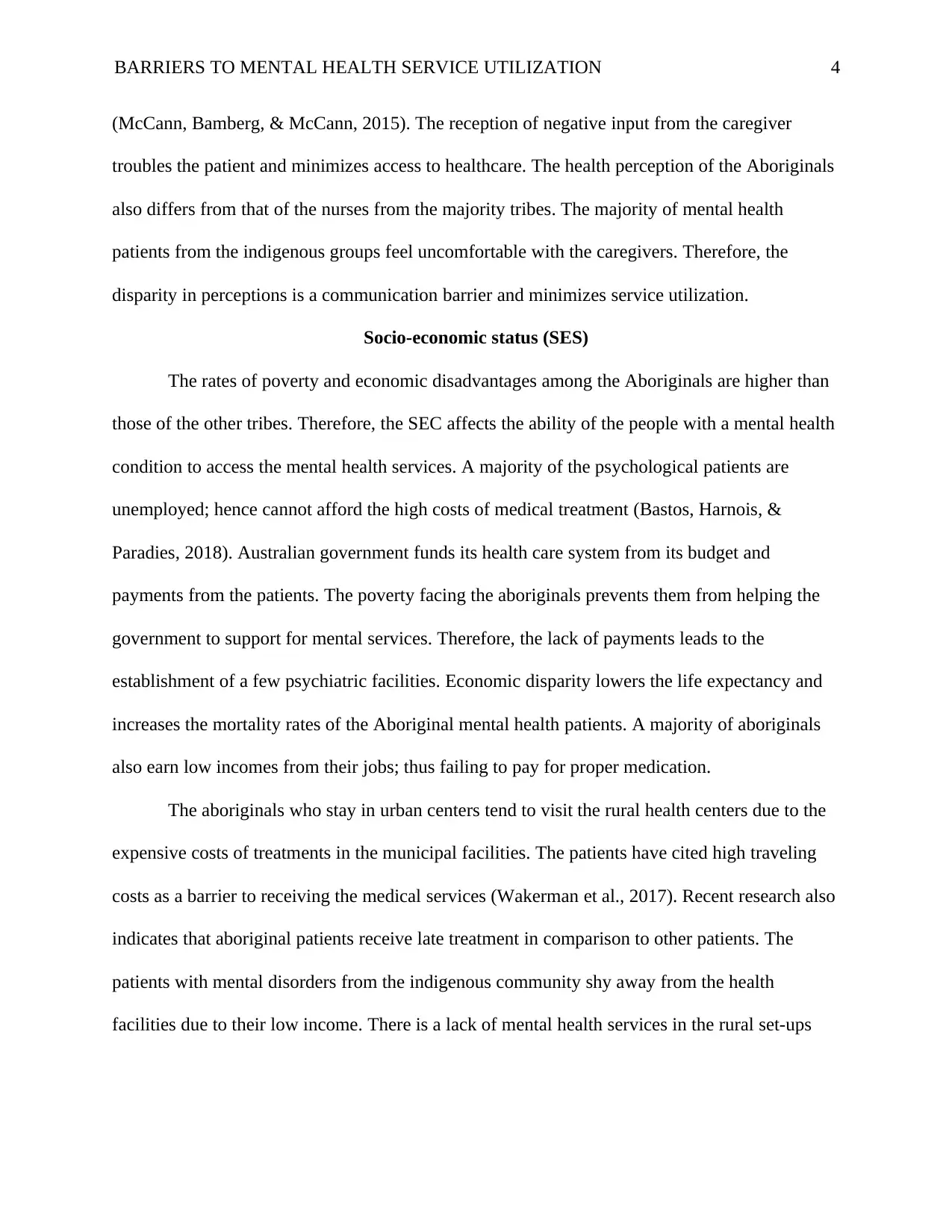
BARRIERS TO MENTAL HEALTH SERVICE UTILIZATION 4
(McCann, Bamberg, & McCann, 2015). The reception of negative input from the caregiver
troubles the patient and minimizes access to healthcare. The health perception of the Aboriginals
also differs from that of the nurses from the majority tribes. The majority of mental health
patients from the indigenous groups feel uncomfortable with the caregivers. Therefore, the
disparity in perceptions is a communication barrier and minimizes service utilization.
Socio-economic status (SES)
The rates of poverty and economic disadvantages among the Aboriginals are higher than
those of the other tribes. Therefore, the SEC affects the ability of the people with a mental health
condition to access the mental health services. A majority of the psychological patients are
unemployed; hence cannot afford the high costs of medical treatment (Bastos, Harnois, &
Paradies, 2018). Australian government funds its health care system from its budget and
payments from the patients. The poverty facing the aboriginals prevents them from helping the
government to support for mental services. Therefore, the lack of payments leads to the
establishment of a few psychiatric facilities. Economic disparity lowers the life expectancy and
increases the mortality rates of the Aboriginal mental health patients. A majority of aboriginals
also earn low incomes from their jobs; thus failing to pay for proper medication.
The aboriginals who stay in urban centers tend to visit the rural health centers due to the
expensive costs of treatments in the municipal facilities. The patients have cited high traveling
costs as a barrier to receiving the medical services (Wakerman et al., 2017). Recent research also
indicates that aboriginal patients receive late treatment in comparison to other patients. The
patients with mental disorders from the indigenous community shy away from the health
facilities due to their low income. There is a lack of mental health services in the rural set-ups
(McCann, Bamberg, & McCann, 2015). The reception of negative input from the caregiver
troubles the patient and minimizes access to healthcare. The health perception of the Aboriginals
also differs from that of the nurses from the majority tribes. The majority of mental health
patients from the indigenous groups feel uncomfortable with the caregivers. Therefore, the
disparity in perceptions is a communication barrier and minimizes service utilization.
Socio-economic status (SES)
The rates of poverty and economic disadvantages among the Aboriginals are higher than
those of the other tribes. Therefore, the SEC affects the ability of the people with a mental health
condition to access the mental health services. A majority of the psychological patients are
unemployed; hence cannot afford the high costs of medical treatment (Bastos, Harnois, &
Paradies, 2018). Australian government funds its health care system from its budget and
payments from the patients. The poverty facing the aboriginals prevents them from helping the
government to support for mental services. Therefore, the lack of payments leads to the
establishment of a few psychiatric facilities. Economic disparity lowers the life expectancy and
increases the mortality rates of the Aboriginal mental health patients. A majority of aboriginals
also earn low incomes from their jobs; thus failing to pay for proper medication.
The aboriginals who stay in urban centers tend to visit the rural health centers due to the
expensive costs of treatments in the municipal facilities. The patients have cited high traveling
costs as a barrier to receiving the medical services (Wakerman et al., 2017). Recent research also
indicates that aboriginal patients receive late treatment in comparison to other patients. The
patients with mental disorders from the indigenous community shy away from the health
facilities due to their low income. There is a lack of mental health services in the rural set-ups
Paraphrase This Document
Need a fresh take? Get an instant paraphrase of this document with our AI Paraphraser
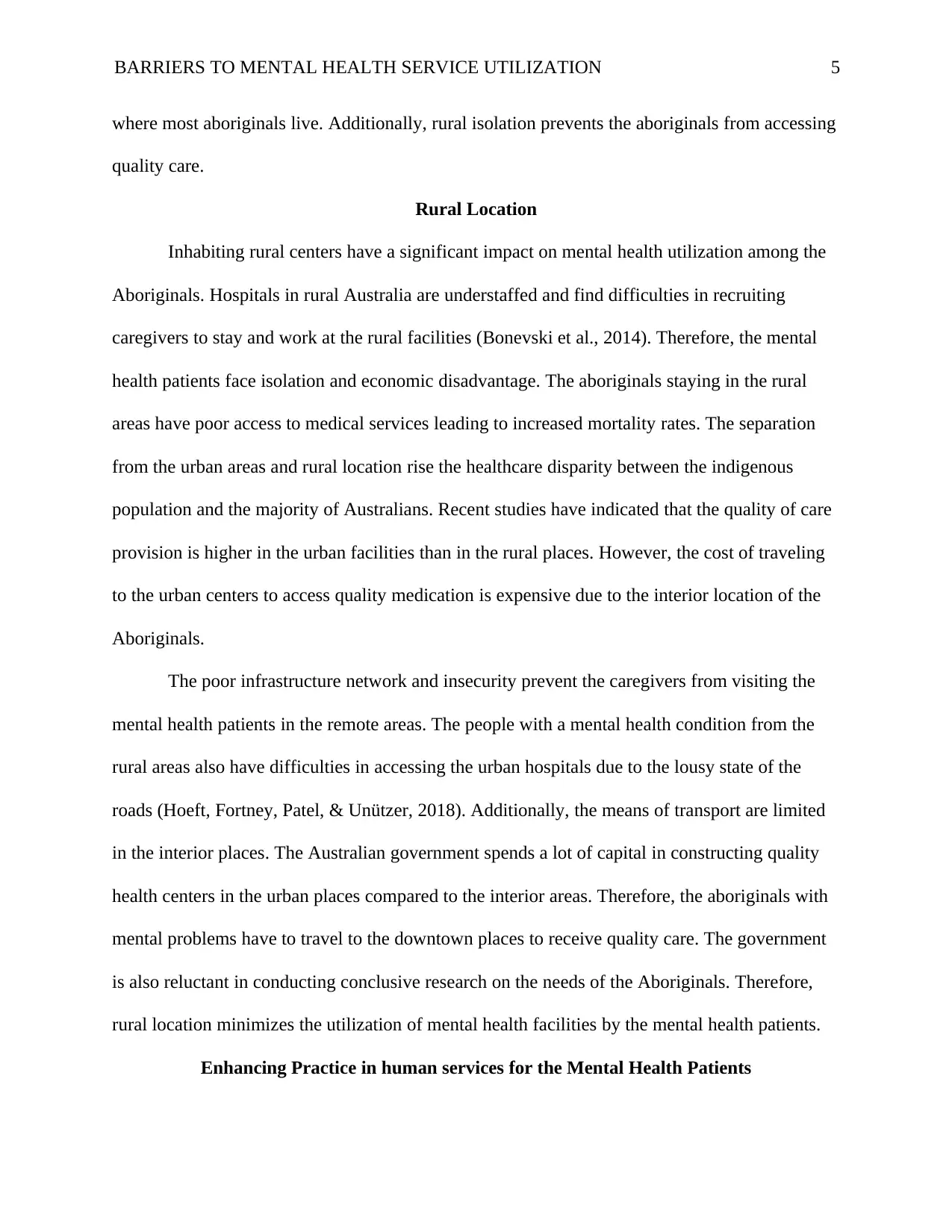
BARRIERS TO MENTAL HEALTH SERVICE UTILIZATION 5
where most aboriginals live. Additionally, rural isolation prevents the aboriginals from accessing
quality care.
Rural Location
Inhabiting rural centers have a significant impact on mental health utilization among the
Aboriginals. Hospitals in rural Australia are understaffed and find difficulties in recruiting
caregivers to stay and work at the rural facilities (Bonevski et al., 2014). Therefore, the mental
health patients face isolation and economic disadvantage. The aboriginals staying in the rural
areas have poor access to medical services leading to increased mortality rates. The separation
from the urban areas and rural location rise the healthcare disparity between the indigenous
population and the majority of Australians. Recent studies have indicated that the quality of care
provision is higher in the urban facilities than in the rural places. However, the cost of traveling
to the urban centers to access quality medication is expensive due to the interior location of the
Aboriginals.
The poor infrastructure network and insecurity prevent the caregivers from visiting the
mental health patients in the remote areas. The people with a mental health condition from the
rural areas also have difficulties in accessing the urban hospitals due to the lousy state of the
roads (Hoeft, Fortney, Patel, & Unützer, 2018). Additionally, the means of transport are limited
in the interior places. The Australian government spends a lot of capital in constructing quality
health centers in the urban places compared to the interior areas. Therefore, the aboriginals with
mental problems have to travel to the downtown places to receive quality care. The government
is also reluctant in conducting conclusive research on the needs of the Aboriginals. Therefore,
rural location minimizes the utilization of mental health facilities by the mental health patients.
Enhancing Practice in human services for the Mental Health Patients
where most aboriginals live. Additionally, rural isolation prevents the aboriginals from accessing
quality care.
Rural Location
Inhabiting rural centers have a significant impact on mental health utilization among the
Aboriginals. Hospitals in rural Australia are understaffed and find difficulties in recruiting
caregivers to stay and work at the rural facilities (Bonevski et al., 2014). Therefore, the mental
health patients face isolation and economic disadvantage. The aboriginals staying in the rural
areas have poor access to medical services leading to increased mortality rates. The separation
from the urban areas and rural location rise the healthcare disparity between the indigenous
population and the majority of Australians. Recent studies have indicated that the quality of care
provision is higher in the urban facilities than in the rural places. However, the cost of traveling
to the urban centers to access quality medication is expensive due to the interior location of the
Aboriginals.
The poor infrastructure network and insecurity prevent the caregivers from visiting the
mental health patients in the remote areas. The people with a mental health condition from the
rural areas also have difficulties in accessing the urban hospitals due to the lousy state of the
roads (Hoeft, Fortney, Patel, & Unützer, 2018). Additionally, the means of transport are limited
in the interior places. The Australian government spends a lot of capital in constructing quality
health centers in the urban places compared to the interior areas. Therefore, the aboriginals with
mental problems have to travel to the downtown places to receive quality care. The government
is also reluctant in conducting conclusive research on the needs of the Aboriginals. Therefore,
rural location minimizes the utilization of mental health facilities by the mental health patients.
Enhancing Practice in human services for the Mental Health Patients
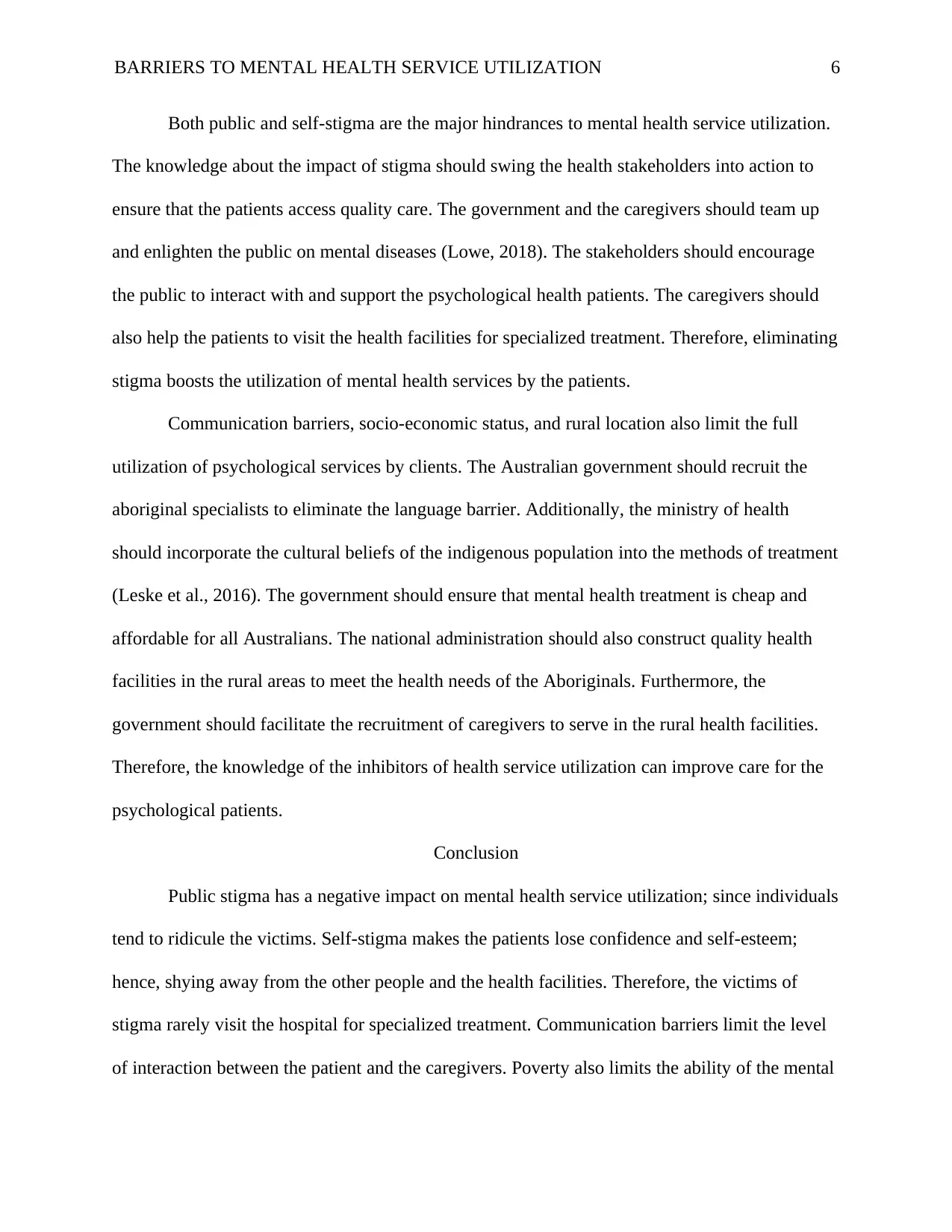
BARRIERS TO MENTAL HEALTH SERVICE UTILIZATION 6
Both public and self-stigma are the major hindrances to mental health service utilization.
The knowledge about the impact of stigma should swing the health stakeholders into action to
ensure that the patients access quality care. The government and the caregivers should team up
and enlighten the public on mental diseases (Lowe, 2018). The stakeholders should encourage
the public to interact with and support the psychological health patients. The caregivers should
also help the patients to visit the health facilities for specialized treatment. Therefore, eliminating
stigma boosts the utilization of mental health services by the patients.
Communication barriers, socio-economic status, and rural location also limit the full
utilization of psychological services by clients. The Australian government should recruit the
aboriginal specialists to eliminate the language barrier. Additionally, the ministry of health
should incorporate the cultural beliefs of the indigenous population into the methods of treatment
(Leske et al., 2016). The government should ensure that mental health treatment is cheap and
affordable for all Australians. The national administration should also construct quality health
facilities in the rural areas to meet the health needs of the Aboriginals. Furthermore, the
government should facilitate the recruitment of caregivers to serve in the rural health facilities.
Therefore, the knowledge of the inhibitors of health service utilization can improve care for the
psychological patients.
Conclusion
Public stigma has a negative impact on mental health service utilization; since individuals
tend to ridicule the victims. Self-stigma makes the patients lose confidence and self-esteem;
hence, shying away from the other people and the health facilities. Therefore, the victims of
stigma rarely visit the hospital for specialized treatment. Communication barriers limit the level
of interaction between the patient and the caregivers. Poverty also limits the ability of the mental
Both public and self-stigma are the major hindrances to mental health service utilization.
The knowledge about the impact of stigma should swing the health stakeholders into action to
ensure that the patients access quality care. The government and the caregivers should team up
and enlighten the public on mental diseases (Lowe, 2018). The stakeholders should encourage
the public to interact with and support the psychological health patients. The caregivers should
also help the patients to visit the health facilities for specialized treatment. Therefore, eliminating
stigma boosts the utilization of mental health services by the patients.
Communication barriers, socio-economic status, and rural location also limit the full
utilization of psychological services by clients. The Australian government should recruit the
aboriginal specialists to eliminate the language barrier. Additionally, the ministry of health
should incorporate the cultural beliefs of the indigenous population into the methods of treatment
(Leske et al., 2016). The government should ensure that mental health treatment is cheap and
affordable for all Australians. The national administration should also construct quality health
facilities in the rural areas to meet the health needs of the Aboriginals. Furthermore, the
government should facilitate the recruitment of caregivers to serve in the rural health facilities.
Therefore, the knowledge of the inhibitors of health service utilization can improve care for the
psychological patients.
Conclusion
Public stigma has a negative impact on mental health service utilization; since individuals
tend to ridicule the victims. Self-stigma makes the patients lose confidence and self-esteem;
hence, shying away from the other people and the health facilities. Therefore, the victims of
stigma rarely visit the hospital for specialized treatment. Communication barriers limit the level
of interaction between the patient and the caregivers. Poverty also limits the ability of the mental
⊘ This is a preview!⊘
Do you want full access?
Subscribe today to unlock all pages.

Trusted by 1+ million students worldwide
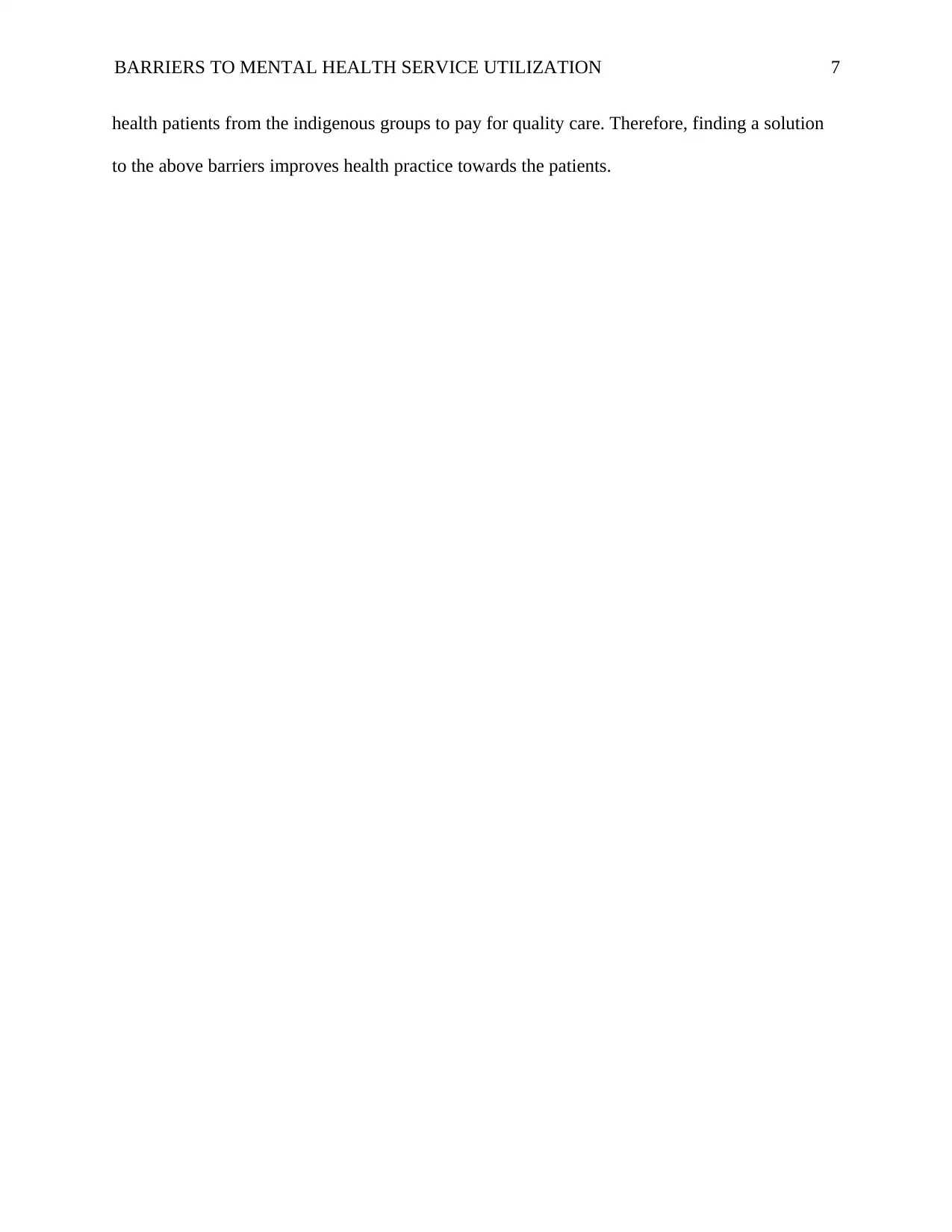
BARRIERS TO MENTAL HEALTH SERVICE UTILIZATION 7
health patients from the indigenous groups to pay for quality care. Therefore, finding a solution
to the above barriers improves health practice towards the patients.
health patients from the indigenous groups to pay for quality care. Therefore, finding a solution
to the above barriers improves health practice towards the patients.
Paraphrase This Document
Need a fresh take? Get an instant paraphrase of this document with our AI Paraphraser
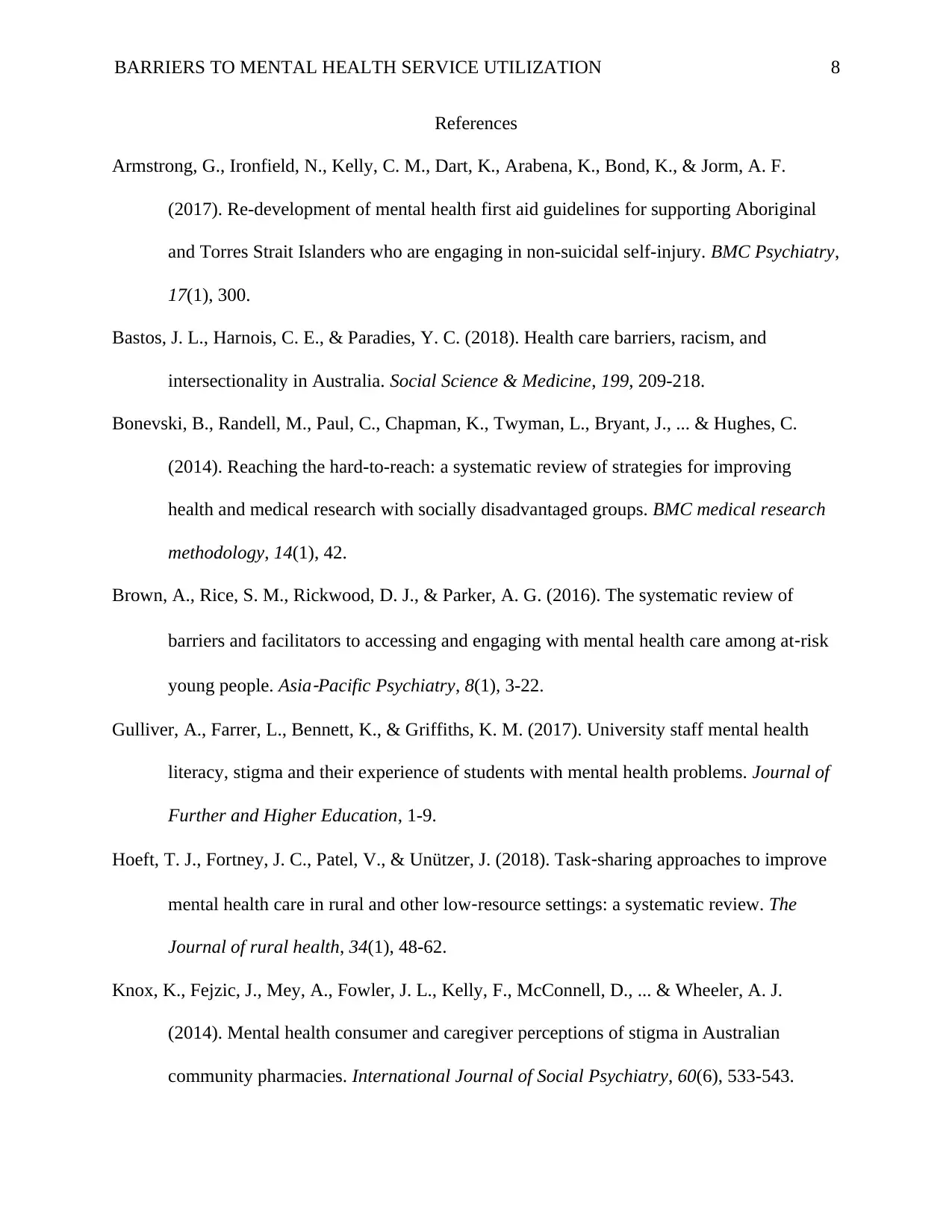
BARRIERS TO MENTAL HEALTH SERVICE UTILIZATION 8
References
Armstrong, G., Ironfield, N., Kelly, C. M., Dart, K., Arabena, K., Bond, K., & Jorm, A. F.
(2017). Re-development of mental health first aid guidelines for supporting Aboriginal
and Torres Strait Islanders who are engaging in non-suicidal self-injury. BMC Psychiatry,
17(1), 300.
Bastos, J. L., Harnois, C. E., & Paradies, Y. C. (2018). Health care barriers, racism, and
intersectionality in Australia. Social Science & Medicine, 199, 209-218.
Bonevski, B., Randell, M., Paul, C., Chapman, K., Twyman, L., Bryant, J., ... & Hughes, C.
(2014). Reaching the hard-to-reach: a systematic review of strategies for improving
health and medical research with socially disadvantaged groups. BMC medical research
methodology, 14(1), 42.
Brown, A., Rice, S. M., Rickwood, D. J., & Parker, A. G. (2016). The systematic review of
barriers and facilitators to accessing and engaging with mental health care among at‐risk
young people. Asia
‐Pacific Psychiatry, 8(1), 3-22.
Gulliver, A., Farrer, L., Bennett, K., & Griffiths, K. M. (2017). University staff mental health
literacy, stigma and their experience of students with mental health problems. Journal of
Further and Higher Education, 1-9.
Hoeft, T. J., Fortney, J. C., Patel, V., & Unützer, J. (2018). Task‐sharing approaches to improve
mental health care in rural and other low‐resource settings: a systematic review. The
Journal of rural health, 34(1), 48-62.
Knox, K., Fejzic, J., Mey, A., Fowler, J. L., Kelly, F., McConnell, D., ... & Wheeler, A. J.
(2014). Mental health consumer and caregiver perceptions of stigma in Australian
community pharmacies. International Journal of Social Psychiatry, 60(6), 533-543.
References
Armstrong, G., Ironfield, N., Kelly, C. M., Dart, K., Arabena, K., Bond, K., & Jorm, A. F.
(2017). Re-development of mental health first aid guidelines for supporting Aboriginal
and Torres Strait Islanders who are engaging in non-suicidal self-injury. BMC Psychiatry,
17(1), 300.
Bastos, J. L., Harnois, C. E., & Paradies, Y. C. (2018). Health care barriers, racism, and
intersectionality in Australia. Social Science & Medicine, 199, 209-218.
Bonevski, B., Randell, M., Paul, C., Chapman, K., Twyman, L., Bryant, J., ... & Hughes, C.
(2014). Reaching the hard-to-reach: a systematic review of strategies for improving
health and medical research with socially disadvantaged groups. BMC medical research
methodology, 14(1), 42.
Brown, A., Rice, S. M., Rickwood, D. J., & Parker, A. G. (2016). The systematic review of
barriers and facilitators to accessing and engaging with mental health care among at‐risk
young people. Asia
‐Pacific Psychiatry, 8(1), 3-22.
Gulliver, A., Farrer, L., Bennett, K., & Griffiths, K. M. (2017). University staff mental health
literacy, stigma and their experience of students with mental health problems. Journal of
Further and Higher Education, 1-9.
Hoeft, T. J., Fortney, J. C., Patel, V., & Unützer, J. (2018). Task‐sharing approaches to improve
mental health care in rural and other low‐resource settings: a systematic review. The
Journal of rural health, 34(1), 48-62.
Knox, K., Fejzic, J., Mey, A., Fowler, J. L., Kelly, F., McConnell, D., ... & Wheeler, A. J.
(2014). Mental health consumer and caregiver perceptions of stigma in Australian
community pharmacies. International Journal of Social Psychiatry, 60(6), 533-543.
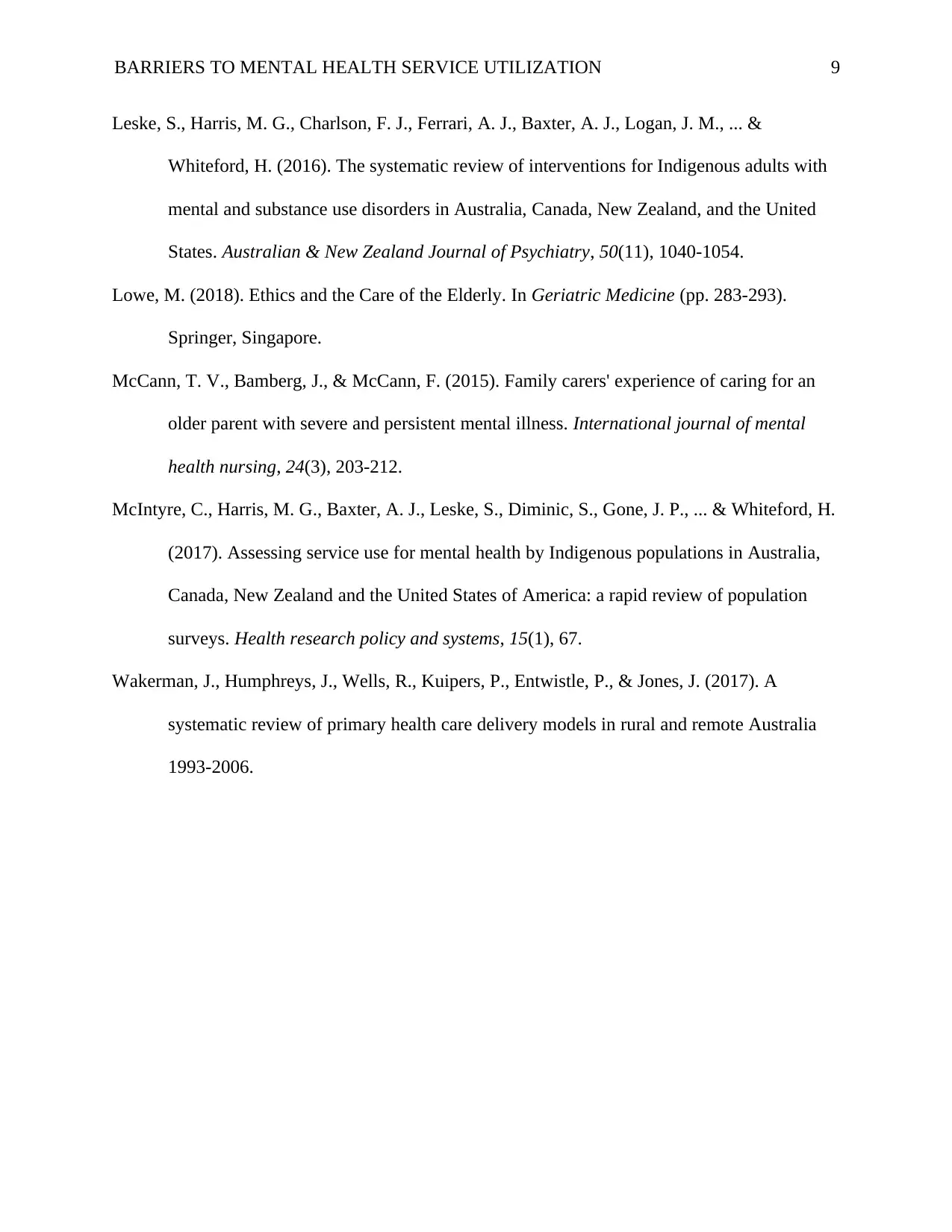
BARRIERS TO MENTAL HEALTH SERVICE UTILIZATION 9
Leske, S., Harris, M. G., Charlson, F. J., Ferrari, A. J., Baxter, A. J., Logan, J. M., ... &
Whiteford, H. (2016). The systematic review of interventions for Indigenous adults with
mental and substance use disorders in Australia, Canada, New Zealand, and the United
States. Australian & New Zealand Journal of Psychiatry, 50(11), 1040-1054.
Lowe, M. (2018). Ethics and the Care of the Elderly. In Geriatric Medicine (pp. 283-293).
Springer, Singapore.
McCann, T. V., Bamberg, J., & McCann, F. (2015). Family carers' experience of caring for an
older parent with severe and persistent mental illness. International journal of mental
health nursing, 24(3), 203-212.
McIntyre, C., Harris, M. G., Baxter, A. J., Leske, S., Diminic, S., Gone, J. P., ... & Whiteford, H.
(2017). Assessing service use for mental health by Indigenous populations in Australia,
Canada, New Zealand and the United States of America: a rapid review of population
surveys. Health research policy and systems, 15(1), 67.
Wakerman, J., Humphreys, J., Wells, R., Kuipers, P., Entwistle, P., & Jones, J. (2017). A
systematic review of primary health care delivery models in rural and remote Australia
1993-2006.
Leske, S., Harris, M. G., Charlson, F. J., Ferrari, A. J., Baxter, A. J., Logan, J. M., ... &
Whiteford, H. (2016). The systematic review of interventions for Indigenous adults with
mental and substance use disorders in Australia, Canada, New Zealand, and the United
States. Australian & New Zealand Journal of Psychiatry, 50(11), 1040-1054.
Lowe, M. (2018). Ethics and the Care of the Elderly. In Geriatric Medicine (pp. 283-293).
Springer, Singapore.
McCann, T. V., Bamberg, J., & McCann, F. (2015). Family carers' experience of caring for an
older parent with severe and persistent mental illness. International journal of mental
health nursing, 24(3), 203-212.
McIntyre, C., Harris, M. G., Baxter, A. J., Leske, S., Diminic, S., Gone, J. P., ... & Whiteford, H.
(2017). Assessing service use for mental health by Indigenous populations in Australia,
Canada, New Zealand and the United States of America: a rapid review of population
surveys. Health research policy and systems, 15(1), 67.
Wakerman, J., Humphreys, J., Wells, R., Kuipers, P., Entwistle, P., & Jones, J. (2017). A
systematic review of primary health care delivery models in rural and remote Australia
1993-2006.
⊘ This is a preview!⊘
Do you want full access?
Subscribe today to unlock all pages.

Trusted by 1+ million students worldwide
1 out of 9
Related Documents
Your All-in-One AI-Powered Toolkit for Academic Success.
+13062052269
info@desklib.com
Available 24*7 on WhatsApp / Email
![[object Object]](/_next/static/media/star-bottom.7253800d.svg)
Unlock your academic potential
Copyright © 2020–2026 A2Z Services. All Rights Reserved. Developed and managed by ZUCOL.





